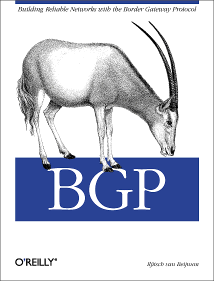
|

|

|
|
Home ·
BGP Expert Test ·
What is BGP? ·
BGP Vendors ·
Links ·
Archives ·
Books ·
My New BGP Book | ||
 (advertisement)
(advertisement)
| ||
|
TCP high performance and maximum usable bandwidth (posted 2002-03-31)
The second half of Februari saw two main topics on the NANOG list: DS3 performance and satellite latency. The long round trip times for satellite connections wreak havoc on TCP performance. In order to be able to utilize the available bandwidth, TCP needs to keep sending data without waiting for an acknowledgment for at least a full round trip time. Or in other words: TCP performance is limited to the window size multiplied by the round trip time. The TCP window (amount of data TCP will send before stopping and waiting for an acknowledgment) is limited by two factors: the send buffer on the sending system and the 16 bit window size field in the TCP header. So on a 600 ms RTT satellite link the maximum TCP performance is limited to 107 kilobytes per second (850 kbps) by the size of the header field, and if a sender uses a 16 kilobyte buffer (a fairly common size) this drops to as little as 27 kilobytes per second (215 kbps). Because of the TCP slow start mechanism, it takes several seconds to reach this speed as well. Fortunately, RFC 1323, TCP Extensions for High Performance introduces a "window scale" option to increase the TCP window to a maximum of 1 GB, if both ends of the connection allocate enough buffer space. The other subject that received a lot of attention, the maximum usable bandwidth of a DS3/T3 line, is also related to TCP performance. When the line gets close to being fully utilized, short data bursts (which are very common in IP) will fill up the send queue. When the queue is full, additional incoming packets are discarded. This is called a "tail drop". If the TCP session which loses a packet doesn't support "fast retransmit", or if several packets from the same session are dropped, this TCP session will go into "slow start" and slow down a lot. This often happens to several TCP sessions at the same time, so those now all perform slow start at the same time. So they all reach the point where the line can't handle the traffic load at the same time, and another small burst will trigger another round of tail drops. A possible solution is to use Random Early Detect (RED) queuing rather than First In, First Out (FIFO). RED will start dropping more and more packets as the queue fills up, to trigger TCP congestion avoidance and slow down the TCP sessions more gently. But this only works if there aren't (m)any tail drops, which is unlikely if there is only limited buffer space. Unfortunately, Cisco uses a default queue size of 40 packets. Queuing theory tells us this queue will be filled entirely (on average) at 97% line utilization. So at 97%, even a one packet burst will result in a tail drop. The solution is to increase the queue size, in addition to enabling RED. On a Cisco:
interface ATM0 This gives RED the opportunity to start dropping individual packets long before the queue fills up entirely and tail drops occur. The price is a somewhat longer queuing delay. At 99% utilization, there will be an average of 98 packets in the queue, but at 45 Mbps this will only introduce a delay of 9 ms.
|
